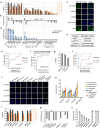Widespread stable noncanonical peptides identified by integrated analyses of ribosome profiling and ORF features
- PMID: 38431639
- PMCID: PMC10908861
- DOI: 10.1038/s41467-024-46240-9
Widespread stable noncanonical peptides identified by integrated analyses of ribosome profiling and ORF features
Abstract
Studies have revealed dozens of functional peptides in putative 'noncoding' regions and raised the question of how many proteins are encoded by noncanonical open reading frames (ORFs). Here, we comprehensively annotate genome-wide translated ORFs across five eukaryotes (human, mouse, zebrafish, worm, and yeast) by analyzing ribosome profiling data. We develop a logistic regression model named PepScore based on ORF features (expected length, encoded domain, and conservation) to calculate the probability that the encoded peptide is stable in humans. Systematic ectopic expression validates PepScore and shows that stable complex-associating microproteins can be encoded in 5'/3' untranslated regions and overlapping coding regions of mRNAs besides annotated noncoding RNAs. Stable noncanonical proteins follow conventional rules and localize to different subcellular compartments. Inhibition of proteasomal/lysosomal degradation pathways can stabilize some peptides especially those with moderate PepScores, but cannot rescue the expression of short ones with low PepScores suggesting they are directly degraded by cellular proteases. The majority of human noncanonical peptides with high PepScores show longer lengths but low conservation across species/mammals, and hundreds contain trait-associated genetic variants. Our study presents a statistical framework to identify stable noncanonical peptides in the genome and provides a valuable resource for functional characterization of noncanonical translation during development and disease.
© 2024. The Author(s).
Conflict of interest statement
The authors declare no competing interests.
Figures








Similar articles
-
Exploring the Peptide Potential of Genomes.Methods Mol Biol. 2022;2405:63-82. doi: 10.1007/978-1-0716-1855-4_3. Methods Mol Biol. 2022. PMID: 35298808
-
Ribosome profiling reveals hidden world of small proteins.Trends Genet. 2025 Feb;41(2):101-103. doi: 10.1016/j.tig.2024.12.010. Epub 2025 Jan 14. Trends Genet. 2025. PMID: 39814675
-
Pervasive functional translation of noncanonical human open reading frames.Science. 2020 Mar 6;367(6482):1140-1146. doi: 10.1126/science.aay0262. Science. 2020. PMID: 32139545 Free PMC article.
-
The dark proteome: translation from noncanonical open reading frames.Trends Cell Biol. 2022 Mar;32(3):243-258. doi: 10.1016/j.tcb.2021.10.010. Epub 2021 Nov 26. Trends Cell Biol. 2022. PMID: 34844857 Free PMC article. Review.
-
Novel insights into noncanonical open reading frames in cancer.Biochim Biophys Acta Rev Cancer. 2022 Jul;1877(4):188755. doi: 10.1016/j.bbcan.2022.188755. Epub 2022 Jun 28. Biochim Biophys Acta Rev Cancer. 2022. PMID: 35777601 Review.
Cited by
-
Current Perspectives on Functional Involvement of Micropeptides in Virus-Host Interactions.Int J Mol Sci. 2025 Apr 12;26(8):3651. doi: 10.3390/ijms26083651. Int J Mol Sci. 2025. PMID: 40332243 Free PMC article. Review.
-
Exploring the Dark Matter of Human Proteome: The Emerging Role of Non-Canonical Open Reading Frame (ncORF) in Cancer Diagnosis, Biology, and Therapy.Cancers (Basel). 2024 Jul 26;16(15):2660. doi: 10.3390/cancers16152660. Cancers (Basel). 2024. PMID: 39123386 Free PMC article. Review.
-
Discovering the hidden function in fungal genomes.Nat Commun. 2024 Sep 19;15(1):8219. doi: 10.1038/s41467-024-52568-z. Nat Commun. 2024. PMID: 39300175 Free PMC article. Review.
-
Finding functional microproteins.Trends Genet. 2025 Feb;41(2):107-118. doi: 10.1016/j.tig.2024.12.001. Epub 2025 Jan 2. Trends Genet. 2025. PMID: 39753408 Review.
-
De novo proteins integrate cellular systems using ancient protein targeting and degradation pathways.bioRxiv [Preprint]. 2025 Jun 20:2024.08.28.610198. doi: 10.1101/2024.08.28.610198. bioRxiv. 2025. PMID: 39257767 Free PMC article. Preprint.
References
-
- Horowitz NH. The one gene-one enzyme hypothesis. Genetics. 1948;33:612. - PubMed
MeSH terms
Substances
Grants and funding
LinkOut - more resources
Full Text Sources
Molecular Biology Databases

